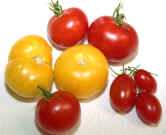|












|
|

Tomatoes:
Member of the nightshade family of plants.
Native to South America, had moved up to Central America and Mexico by
the time European explorers arrived in the New World. The native
tiny wild fruit was cultivated by our pre-Columbian ancestors and by
the time Cortez reached Mexico in 1519, cultivation had already
produced fist-sized tomatoes we would recognize today
When Columbus landed in the new world, he noted that
the natives ate a small yellow fruit which resembled an apple of gold.
Hence it was given the the name Pomodoro (apple of gold).
The fist tomatoes taken to Spain were yellow. Later when Cortez
traveled to Techochlan the Aztec Capitol, which is now Mexico City, he
observed the natives making sauces from red fruits which they called
Nahuatl, or Tomatal and which were not unpleasant to eat. The
natives used the tomato much like we do today in making sauces
and salsas.
Brought back to Spain from Mexico but not used much immediately as it
was believed to be poisonous and viewed as an ornamental plant largely
until18th century .now a staple in much Italian cooking. However the
earliest written mention of the tomato was published in a commentary
on Dioscorides by Petrus Matthiolus in 1544 in Venice did mention the
consumption of tomatoes.
The first reference to the tomato in the United States is William
Salmon's "Botanologia" ( London, 1710). He speaks to tomatoes in
Carolina. The next report does not come until 1766. In
1782, Thomas noted that his garden produced tomatoes. However
Americans didn't even eat them much until mid-19th century also
because of nightshade fears
                                
         |